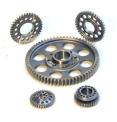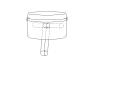![]()
![]()
![]() Home
Home
![]() Motorcycle Types
Motorcycle Types
![]() manufacturers
manufacturers
![]() Motorcycle parts
Motorcycle parts
![]() Resources
Resources
![]() What maters most in
motorcycles
What maters most in
motorcycles
This Web site is an easy guide to give you information about
Motorcycle Parts
The Motorcycle Chassis
The motorcycle chassis consists of the frame, suspension, wheels and brakes. Each of these components are described briefly below. The frame is made of steel, aluminum or an alloy. The frame consists mostly of hollow tubes and serves as a skeleton on which components like the gearbox and engine are mounted. The frame also keeps the wheels in line to maintain the handling of the motorcycle
Wheels
Motorcycle wheels are generally made of aluminum or steel rims with spokes,
although some models that were introduced in the 1970s can offer cast wheels. Cast
wheels allow the bikes to use tubeless tires, which unlike traditional
pneumatic tires, don't have an inner tube to hold the compressed air.
Instead, the air is held between the rim and the tire, relying on a seal
that forms between rim and tire to maintain the internal air pressure.
A tire is made up of several different components.
The
Bead Bundle, The Body, The Belts, The Sidewall, The Tread .
All of these components are assembled in the tire-building machine. This
machine ensures that all of the components are in the correct location and
then forms the tire into a shape and size fairly close to its finished
dimensions.
Brakes
The front and rear wheels on a motorcycle each have a brake.

The rider activates the front brake with a hand lever on the right grip, the rear brake with the right foot pedal. Drum brakes (Shoes press against a spinning surface) were common until the 1970s, but most motorcycles today rely on the superior performance of disc brakes. Disc brakes consist of a steel braking disc, which is connected to the wheel and sandwiched between brake pads. When the rider operates one of the brakes, hydraulic pressure, acting through the brake line, causes the brake pads to squeeze against the disc on both sides. Friction causes the disc and the attached wheel to slow down or stop. Brake pads must be replaced periodically because the pad surfaces wear away after repeated use.
Gearset
A gearset is a set of gears that enable a rider to move from a complete
stop to a cruising speed. Typical transmissions on motorcycles have four
to six gears, although small bikes may have as few as two. The gears are engaged by
shifting a lever, which moves shifting forks inside the transmission.
although small bikes may have as few as two. The gears are engaged by
shifting a lever, which moves shifting forks inside the transmission.
Transmission
A motorcycle engine can create an enormous amount of power, which must be
delivered to the wheels of the vehicle in a controllable way. The
motorcycle transmission delivers power to the rear wheel through a series
of structures that include the gearset, the clutch and the drive system.
Clutch
The job of a clutch is to engage and disengage power from the engine
crankshaft to the transmission. Without the clutch, the only way to stop
the wheels from turning would be to turn off the engine -- an impractical
solution in any kind of motorized vehicle. The clutch is a series of spring-loaded plates that, when pressed
together, connect the transmission to the crankshaft. When a rider wants
to shift gears, he uses the clutch to disconnect the transmission from the
crankshaft. Once the new gear is selected, he uses the clutch to
reestablish the connection.
vehicle. The clutch is a series of spring-loaded plates that, when pressed
together, connect the transmission to the crankshaft. When a rider wants
to shift gears, he uses the clutch to disconnect the transmission from the
crankshaft. Once the new gear is selected, he uses the clutch to
reestablish the connection.
Changing Gears
Early
motorcycle clutches were operated by a foot pedal in the same way that
automobile drivers use clutches. This was awkward and dangerous because it
required that the rider's left foot be off the ground when the bike came
to complete stop (at an intersection, for instance). British designers
solved this problem with a hand-operated clutch.
Today, hand-operated clutches and foot-operated shifters are standard on all models.
Motorcycle Engines
Motorcycle engines consist of pistons, a cylinder block and a head, which
contains the valve train. The pistons move up and down in the cylinder
block, driven by explosions of a fuel-air mixture that has been ignited by
a spark. Valves open and close to allow the fuel-air mixture to enter the
combustion chamber. As the pistons move up and down, they turn a
crankshaft, which transforms the energy from the pistons into rotary
motion. The rotational force of the crankshaft is transmitted, via the
transmission, to the rear wheel of the motorcycle

Motorcycle engines are generally classified by one of three characteristics: the number of cylinders they possess, the capacity of their combustion chambers or the number of strokes in their power cycles.
Cylinders
Motorcycle engines can have between one and six cylinders. For years, the
V-twin design was the engine of choice for motorcycle engineers in
America, Europe and Japan. The V-twin gets its name from the fact that the
two cylinders form a V shape, such as the classic Harley-Davidson V-twin
shown below. Notice the 45-degree angle in the Harley-Davidson V-twin --
other manufacturers may vary this angle to reduce vibration.The V-twin is
just one way to accommodate two cylinders. When the cylinders are oriented
so that the pistons oppose each other, the result is an opposed-twin
design. Parallel-twin engines have their pistons placed side by side in an
upright position. the most popular design is the four-cylinder, which runs
more smoothly and at higher revolutions per minute (rpms) than a
comparable twin. The four cylinders can be placed in a row, or they can be
arranged in a V-shape configuration, with two cylinders on each side of
the V. 
Capacity
The size of the combustion chamber in a motorcycle engine is directly
related to its power output. The upper limit is about 1500 cubic
centimeters (cc), while the lower limit is about 50 cc. The latter engines
are usually found on small motorcycles (mopeds) that offer
100-miles-to-the-gallon fuel economy but can only reach top speeds of 30 to 35
miles per hour.

Insured it. Get your motorcycle insurance. Just in case you encounter
collision with another automobile, side-swept a person or other forms of
compensatory instances, the insurance company will answer for the damages.
We must realize that everything is a compromise. As a consequence, it is
vital therefore to be careful and to understand implications. An ounce of
prevention is a pound of cure. Though said maxim is already ages old,
still, it has perpetual stigma.
|
|
|
How to navigate in this web-siteThe web-site is organized by dates. It contain motorcycles history from the end of 1800' until almost today. The history is delivered to you by the most important motorcycles ever built and who influence the industry and motorcycle riders.
|
|
|